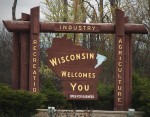 Yet another travel series that I never seem to finish. This one tells the tales of our Milwaukee adventures in late March of 2012. We went there to do some serious drinking. Oh, and also Trevtastic got married. Yeah, some girl actually married that boy. But still, it was a good excuse to show the Lady Friend the various drinking landmarks of Milwaukee, so that’s what we did. Wistful wanderings in Wisco. Part 1 is here.
Yet another travel series that I never seem to finish. This one tells the tales of our Milwaukee adventures in late March of 2012. We went there to do some serious drinking. Oh, and also Trevtastic got married. Yeah, some girl actually married that boy. But still, it was a good excuse to show the Lady Friend the various drinking landmarks of Milwaukee, so that’s what we did. Wistful wanderings in Wisco. Part 1 is here.
Yah dere hey.
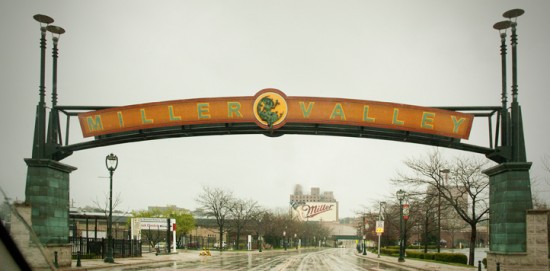
Friday morning was rather dreary and damp, but we had drinking to do. The first stop of the day was the behemoth complex of the Miller Brewing Company. Obviously, I’m a craft beer fan, but with many friends in the Midwest, and several trips to Milwaukee, I’ve had my fair share of Miller Lite as well. I insisted that the Miller tour was a mandatory part of our trip for the Lady Friend, so she can truly appreciate the SCALE of these macrobreweries. The facility in Milwaukee produces 10 MILLION BARRELS of beer every year, and that’s just one of their 11 breweries across the country. By comparison, Harpoon Brewery in Boston produces 125,000 bbls a year. Miller makes 80 TIMES more beer from ONE facility. It’s absolutely mind-blowing.
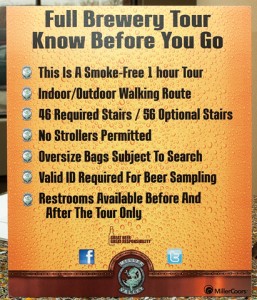 So, we started our tour. It’s free, but has a number of rules and warnings. Nothing too scary, but yes, there is walking involved, and yes, there are a number of stairs to climb in the brewhouse. It’s not the most fun tour on a rainy or cold day, as you hoof it down the road and in and out of various buildings, but totally worth it in the end. No smoking, no bathroom breaks (this was a concern for the Lady Friend), and no strollers, though if you’re the sort of psychopath that thinks it’s cute and fun to bring very small children who wail incessantly on a public tour, then I hope you develop an ear infection that makes you drastically more sensitive to sound, rendering the cries of your little stinkcritter as unbearable to you as it is to everyone else around you. This goes for airplanes, restaurants, and movies theaters as well. No one likes your horrible offspring except you, so just stay home to raise your brood where you won’t bother the rest of us.
So, we started our tour. It’s free, but has a number of rules and warnings. Nothing too scary, but yes, there is walking involved, and yes, there are a number of stairs to climb in the brewhouse. It’s not the most fun tour on a rainy or cold day, as you hoof it down the road and in and out of various buildings, but totally worth it in the end. No smoking, no bathroom breaks (this was a concern for the Lady Friend), and no strollers, though if you’re the sort of psychopath that thinks it’s cute and fun to bring very small children who wail incessantly on a public tour, then I hope you develop an ear infection that makes you drastically more sensitive to sound, rendering the cries of your little stinkcritter as unbearable to you as it is to everyone else around you. This goes for airplanes, restaurants, and movies theaters as well. No one likes your horrible offspring except you, so just stay home to raise your brood where you won’t bother the rest of us.
Yes, there were some children on this tour… what makes you ask?
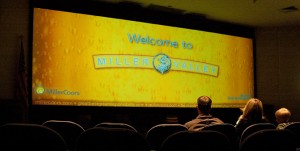 Anyway, they start off by taking your picture in front of a painted Miller mural in the lobby that you can purchase later, packaged with a keychain, for about $20. A nice Disney-level scam to add to the magic. The actual tour begins with a little propaganda film that tells a brief history of Miller Brewing so the tour guides don’t have to. They changed the film since the last tour I took, where the slogan “It’s Miller Time!” was flashed so many times on the screen that it was laughable. I stopped counting at
Anyway, they start off by taking your picture in front of a painted Miller mural in the lobby that you can purchase later, packaged with a keychain, for about $20. A nice Disney-level scam to add to the magic. The actual tour begins with a little propaganda film that tells a brief history of Miller Brewing so the tour guides don’t have to. They changed the film since the last tour I took, where the slogan “It’s Miller Time!” was flashed so many times on the screen that it was laughable. I stopped counting at 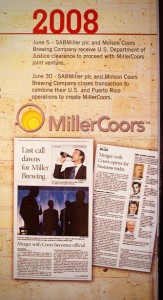 15 references in a 10-minute film. However, that’s gone now, and they focus instead on a Katy Perry-wannabe dressed as the Girl in the Moon logo from the Miller High Life branding. According to the film, the brewery was started in 1855 by German immigrant Frederick Miller, when he purchased the Plank-Road Brewery. They brewed 300 bbls in their first year, and really expanded the brand in 1871, when they provided beer to the citizens of Chicago following the Great Fire. Ownership of the company finally left the family when Miller’s anti-alcohol granddaughter sold the majority to W.R. Grace and Company in 1966, which was later purchased by Phillip Morris in 1969. Miller Lite came along in 1973, creating a new horrific category of “low-calorie” beers. In 2002, Phillip Morris sold Miller to South African Breweries (SAB) to create SABMiller, similar to Budweiser’s Anheuser-Busch InBev conglomerate. In 2007, SABMiller and the Molson Coors Brewing Company combined to create the MillerCoors joint venture, which is currently where the branding remains today. So, Miller Brewing Company is actually SABMiller in a joint venture with MillerCoors. Big business.
15 references in a 10-minute film. However, that’s gone now, and they focus instead on a Katy Perry-wannabe dressed as the Girl in the Moon logo from the Miller High Life branding. According to the film, the brewery was started in 1855 by German immigrant Frederick Miller, when he purchased the Plank-Road Brewery. They brewed 300 bbls in their first year, and really expanded the brand in 1871, when they provided beer to the citizens of Chicago following the Great Fire. Ownership of the company finally left the family when Miller’s anti-alcohol granddaughter sold the majority to W.R. Grace and Company in 1966, which was later purchased by Phillip Morris in 1969. Miller Lite came along in 1973, creating a new horrific category of “low-calorie” beers. In 2002, Phillip Morris sold Miller to South African Breweries (SAB) to create SABMiller, similar to Budweiser’s Anheuser-Busch InBev conglomerate. In 2007, SABMiller and the Molson Coors Brewing Company combined to create the MillerCoors joint venture, which is currently where the branding remains today. So, Miller Brewing Company is actually SABMiller in a joint venture with MillerCoors. Big business.
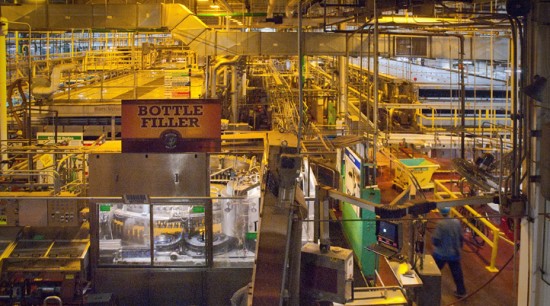
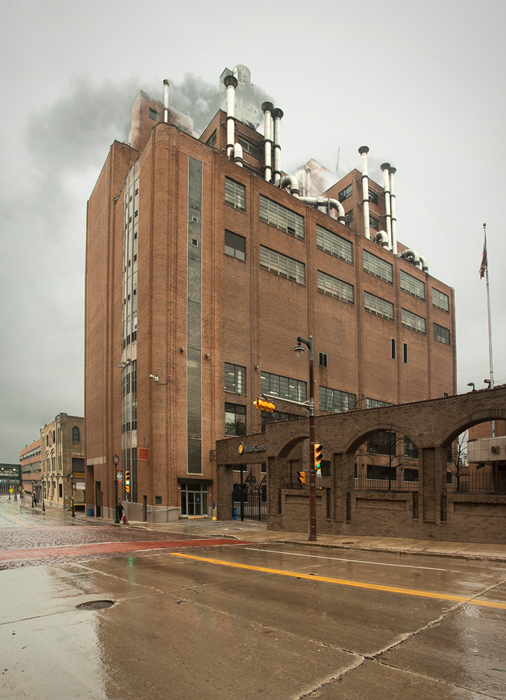
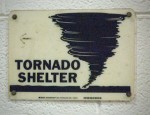 Following the film, the tour guide takes over. Our guide, whose name I didn’t catch, was like an excitable version of a T.G.I. Friday’s waiter on meth. You know that overly-friendly “everything is magical and happy here, all day, every day, never any problems nope nope nope” tooth-grinding forced-smile kind of attitude? Like that. As if he’d be beaten with a pillowcase full of Miller Lite cans for not reaching his smile quota, or having too few pieces of flair. So Chipper McGee led us on a short walk down the street to the bottling plant and distribution warehouse. They put the beer into bottles, cans, and kegs, and ship it out. There’s really not much else to tell about this place, except for throwing out some numbers. Staggering numbers. They package 500,000 cases of beer per DAY,
Following the film, the tour guide takes over. Our guide, whose name I didn’t catch, was like an excitable version of a T.G.I. Friday’s waiter on meth. You know that overly-friendly “everything is magical and happy here, all day, every day, never any problems nope nope nope” tooth-grinding forced-smile kind of attitude? Like that. As if he’d be beaten with a pillowcase full of Miller Lite cans for not reaching his smile quota, or having too few pieces of flair. So Chipper McGee led us on a short walk down the street to the bottling plant and distribution warehouse. They put the beer into bottles, cans, and kegs, and ship it out. There’s really not much else to tell about this place, except for throwing out some numbers. Staggering numbers. They package 500,000 cases of beer per DAY, 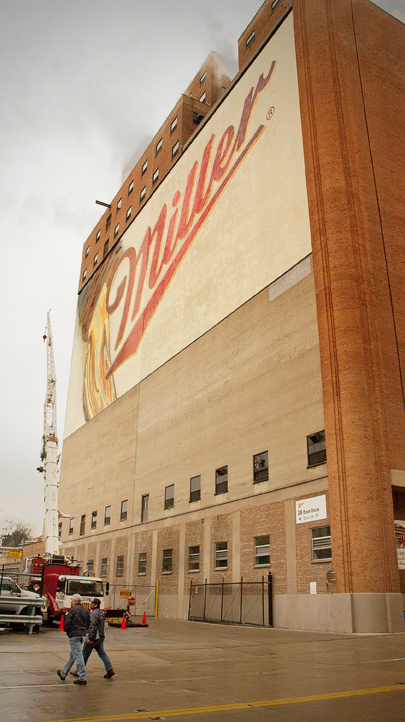 enough beer to fill 30,000 Olympic-sized swimming pools in a year. 60% of the beer goes to cans, 30% to bottles, and the remaining 10% into kegs. It’s pretty quick too: 1400 bottles are filled per minute, while cans can go at 2000 per minute (1.5 cases per second). 15,000 kegs are filled per day, going to bars and restaurants nation-wide. The kegs are stored cool, and aren’t pasteurized like the cans and bottles. The big argument there is that pasteurizing (heating the beer, then cooling rapidly to increase shelf-life) eliminates bacteria in the beer. Well, allegedly, it also decreases flavor, which you certainly won’t notice in Miller Lite, but might notice in a hoppy craft brew. That’s why many craft beers are best drunk within a certain window of time, before the hops and flavors start to diminish, whereas a pasteurized macrobrew can likely sit on the shelf for years with no ill-effects. According to Miller, pasteurizing beer buys them 17 weeks of unrefrigerated storage. Ick.
enough beer to fill 30,000 Olympic-sized swimming pools in a year. 60% of the beer goes to cans, 30% to bottles, and the remaining 10% into kegs. It’s pretty quick too: 1400 bottles are filled per minute, while cans can go at 2000 per minute (1.5 cases per second). 15,000 kegs are filled per day, going to bars and restaurants nation-wide. The kegs are stored cool, and aren’t pasteurized like the cans and bottles. The big argument there is that pasteurizing (heating the beer, then cooling rapidly to increase shelf-life) eliminates bacteria in the beer. Well, allegedly, it also decreases flavor, which you certainly won’t notice in Miller Lite, but might notice in a hoppy craft brew. That’s why many craft beers are best drunk within a certain window of time, before the hops and flavors start to diminish, whereas a pasteurized macrobrew can likely sit on the shelf for years with no ill-effects. According to Miller, pasteurizing beer buys them 17 weeks of unrefrigerated storage. Ick.

From the bottling line, we go down to their 200,000 sq ft warehouse, which has a capacity of 500,000 cases. Since they package 500,000 cases per day, there’s a nearly daily turnover rate, which is staggering for that amount of beer. 3% of the product is loaded onto train boxcars (which used to be the primary shipping method back in the day) but the whopping majority, 97%, simply goes into trucks.
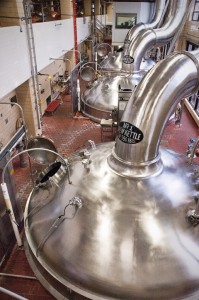 Across the street is the actual brewhouse, a multi-story affair with six, 590 bbl kettles that are 18′ deep, producing 26,000 bbls of beer every DAY. It takes 3-4 weeks to finish the brewing process before the beer is packaged. Miller claims to run at 98% waste free, with their spent grain going to livestock feed. A question about the usage of genetically-modified (GM) hops stopped the otherwise chipper tour guide cold, with a forced smile and shaky reply of “I’m not sure, but I will find out that answer for you!” As we descended the stairs, I remarked to the Lady Friend that perhaps a bigger concern would be the use of GM corn, rather than hops, since Miller is a major producer of adjunct lagers. Later on, at the tasting portion of the tour, the guide informed us that yes, GM hops are used, but with a twist: Miller actually owns several patents on specific hops, I’m assuming some sort of proprietary hybrids. I wasn’t aware you could patent a hop. Moreover, the guide confirmed that yes, lots of GM corn was used as well.
Across the street is the actual brewhouse, a multi-story affair with six, 590 bbl kettles that are 18′ deep, producing 26,000 bbls of beer every DAY. It takes 3-4 weeks to finish the brewing process before the beer is packaged. Miller claims to run at 98% waste free, with their spent grain going to livestock feed. A question about the usage of genetically-modified (GM) hops stopped the otherwise chipper tour guide cold, with a forced smile and shaky reply of “I’m not sure, but I will find out that answer for you!” As we descended the stairs, I remarked to the Lady Friend that perhaps a bigger concern would be the use of GM corn, rather than hops, since Miller is a major producer of adjunct lagers. Later on, at the tasting portion of the tour, the guide informed us that yes, GM hops are used, but with a twist: Miller actually owns several patents on specific hops, I’m assuming some sort of proprietary hybrids. I wasn’t aware you could patent a hop. Moreover, the guide confirmed that yes, lots of GM corn was used as well.
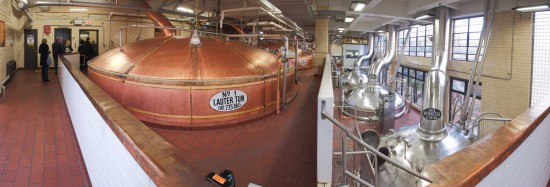
The side of the modern brewhouse is slathered with an absolutely immense mural which can be seen for MILES. The tour guide told me it was one of the largest hand-painted murals in the country. Like most things on the tour, it’s mind-blowingly big.
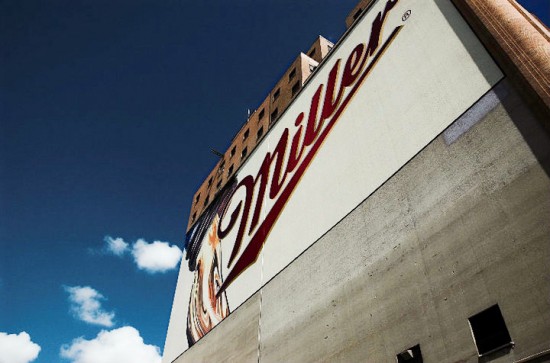
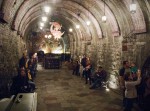 Next, we popped into the “famous caves” built to keep the lager beer cool and happy. Dug into a hillside, the lagering caves were packed with ice to keep the lager yeast satisfied, even in warm summer weather. Ale yeast likes warm (room temp) climates to ferment, while lager needs cooler surroundings. There’s even a “spooky” visitor in the caves: a projected video of the ghost of Frederick Miller, talking about the social, family aspects of his fine German beer. Some of the small children weren’t terribly fond of this portion of the tour, and there was some hullabaloo to that effect.
Next, we popped into the “famous caves” built to keep the lager beer cool and happy. Dug into a hillside, the lagering caves were packed with ice to keep the lager yeast satisfied, even in warm summer weather. Ale yeast likes warm (room temp) climates to ferment, while lager needs cooler surroundings. There’s even a “spooky” visitor in the caves: a projected video of the ghost of Frederick Miller, talking about the social, family aspects of his fine German beer. Some of the small children weren’t terribly fond of this portion of the tour, and there was some hullabaloo to that effect.
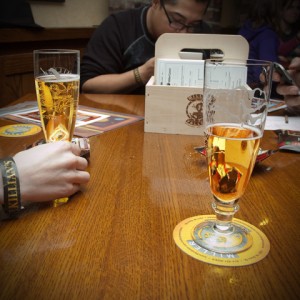 Following the caves, it’s sample time. You’ll either head across the street to the Beer Garden, an outdoor patio, or into the Miller Inn, depending on the season. Last time was a beautiful sunny September day, but the cool rainy climate of this March visit meant we popped into the Inn. There were three samples provided, with a larger-than-usual pour of about 8oz, in a tasting glass (the Beer Garden serves in plastic cups). We went through Miller Lite, Miller High Life, and a new offering, Miller Valley Ale, with a sweetish malt nose and taste, and reddish amber color, dark when compared to the usual pale straw yellow pilsners. It wasn’t bad, but was especially tasty compared to Lite and High Life. But really, what isn’t?
Following the caves, it’s sample time. You’ll either head across the street to the Beer Garden, an outdoor patio, or into the Miller Inn, depending on the season. Last time was a beautiful sunny September day, but the cool rainy climate of this March visit meant we popped into the Inn. There were three samples provided, with a larger-than-usual pour of about 8oz, in a tasting glass (the Beer Garden serves in plastic cups). We went through Miller Lite, Miller High Life, and a new offering, Miller Valley Ale, with a sweetish malt nose and taste, and reddish amber color, dark when compared to the usual pale straw yellow pilsners. It wasn’t bad, but was especially tasty compared to Lite and High Life. But really, what isn’t?

Brewhouse (1886). Modern Brewhouse is on far right of frame.

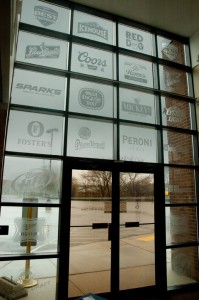 That’s pretty much the tour. You hike back down the road to the main visitor’s building, and can browse the ludicrous number of logo-emblazoned products in the gift shop. We didn’t linger, because there were other stops to make (more breweries!) and we didn’t need any Miller Lite pint glasses. They’re not terribly exclusive. There are quite a few to choose from, as the MillerCoors venture produces Coors, Coors Light, Hamm’s, Icehouse, Keystone, Mickey’s, Miller Genuine Draft, Miller High Life, Miller Lite, Miller 64 (new! It’s Miller Lite LIGHT), Milwaukee’s Best (Beast), Beast Ice, Olde English, Red Dog, Steel Reserve, Blue Moon (Coors’s “craft” beer), Killian’s, the Leinenkugel lineup (bought in 1988), Foster’s, Molson Canadian, Molson Golden, Molson Ice, Molson XXX, Sharps, and Sparks. Oh, and they contract brew PBR. That doesn’t even include the imports owned by SAB. Here’s the full list.
That’s pretty much the tour. You hike back down the road to the main visitor’s building, and can browse the ludicrous number of logo-emblazoned products in the gift shop. We didn’t linger, because there were other stops to make (more breweries!) and we didn’t need any Miller Lite pint glasses. They’re not terribly exclusive. There are quite a few to choose from, as the MillerCoors venture produces Coors, Coors Light, Hamm’s, Icehouse, Keystone, Mickey’s, Miller Genuine Draft, Miller High Life, Miller Lite, Miller 64 (new! It’s Miller Lite LIGHT), Milwaukee’s Best (Beast), Beast Ice, Olde English, Red Dog, Steel Reserve, Blue Moon (Coors’s “craft” beer), Killian’s, the Leinenkugel lineup (bought in 1988), Foster’s, Molson Canadian, Molson Golden, Molson Ice, Molson XXX, Sharps, and Sparks. Oh, and they contract brew PBR. That doesn’t even include the imports owned by SAB. Here’s the full list.
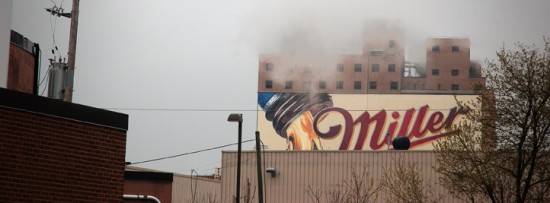
As a whole, the tour doesn’t sound that exciting because it’s a very corporate, very controlled affair, and they really don’t like it when you wander off the marked path or ask uncomfortable questions. It attracts a LOT of tourists and families, so be prepared for that as well. Still, the tour is WELL worth doing if you’re in Milwaukee. It’s free and there are samples at the end. Even if you’re a craft beer/ anti-macro type drinker, you really need to go on this tour just to see the sheer SCALE of this operation. Miller puts out something like 40 MILLION BARRELS of beer a year, with 10 million coming from this facility alone. It’s simply staggering. Go there and see for yourself.
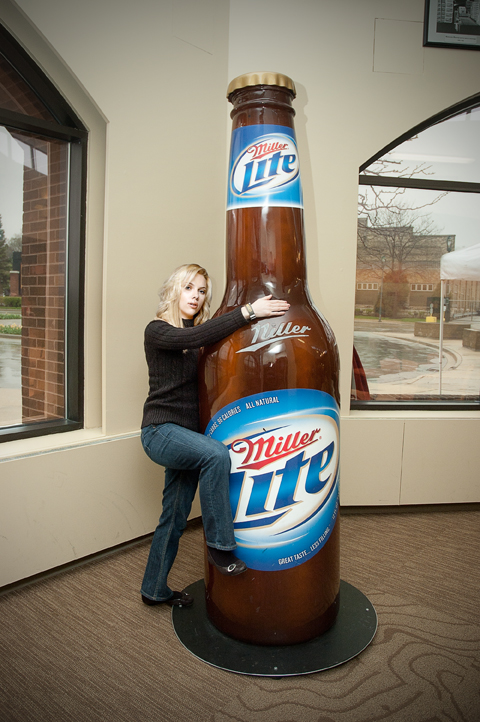
Pingback: Wicked Bueno: Corona, Maine-style | SquirrelFarts Drink Blog